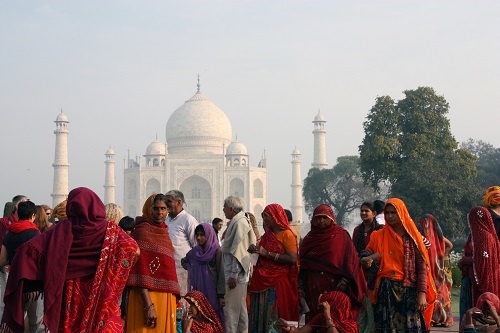pixabay photo
By
Sarthak Goswami
In 2015, when the tourist visits to the Taj Mahal fell by about four per cent, it raised the issue of declining popularity of the monument among foreign tourists. It is nothing exclusive that the Taj Mahal, the greatest testimony to Mughal architecture and India’s most celebrated monument, has been suffering the effects of pollution for several decades now.
The Taj, situated in Agra, is the center of attraction for everyone and has always been on the agenda list of every tourist, celebrity and foreign personnel stepping foot in India. Recently we saw Israel’s Prime Minister Benjamin Netanyahu admiring the marvel of the 16th century monument during his India visit.
The Taj Mahal, which was declared a world heritage site by the UNESCO in 1983, is the backbone of India’s tourism, attracting over 5 million tourists worldwide every year. This contributes a huge proportion in the tourism revenue.
Taj Mahal is under the shadow of chronic pollution. The main causes are the burning of fossil fuels, biomass and garbage. The burning of these elements causes the carbon density in the air to rise, which ultimately ends up depositing on the surface of the monument’s white marble. This contributes in deteriorating the marble and making the white marble dome and minarets of the Taj Mahal turn brownish yellow. Not only this, the illegal construction which happens in the close proximity of the mausoleum is also a major factor in the monument’s disintegration. A study showed that 30% of the carbon deposited on the surface of the monument is brown carbon, which is the major threat to the white marble’s beauty.
While the air in which the Taj breathes beauty is its major enemy, it is not the only one. The polluted Yamuna river, which flows beside the monument, is also directly affecting the circumstances.
According to a report of St John’s College, the polluted Yamuna River has been reduced to a swamp with heavy algal growth and deposit of phosphorus (from ash), which form the primary source of food for this species of insect. The rising pollution level of the Yamuna is now a major threat to the Taj Mahal. Swarms of bugs called Goeldichironomus, which are breeding on its stagnant water, are infesting the marble walls of the monument. The result is greenish black patches on several places on the intricate floral inlay works and ledges.
To save the historical monument from the sting of pollution and urbanization, the government has imposed some laws and regulations which majorly include –
- Banning usage of coal in 10,400 sq kms around the monument
- Banning petrol-diesel vehicles within 500 metres of the Taj Mahal
- Creating a strong green belt in TTZ (Taj Trapezium Zone)
- Cleaning Yamuna and raising its water-level
- Banning the burning of cow dung in Agra
R.K. Dixit, the Archaeological Survey of India (ASI)’s senior official at the Taj says that ASI has been taking steps to clean it. Restorers first used chemical agents, including an ammonia solution. They now use a type of sedimentary clay called fuller’s earth
Although the government has taken several measures to curtail the pollution effect on the Taj Mahal, it all seems to have made hardly any difference. The condition of the Taj Mahal is showing no signs of improving and consequently the tourism has declined marginally last year.
What can be done?
With the advancement of technology humans have found new ways of generating power. One such alternative is solar power. The government is focusing on pumping the city’s energy demand through solar energy, thereby reducing the consumption of fossil fuel and battling air pollution. The government of Uttar Pradesh should plan on making Agra a solar city to salvage the Taj. Laws and prepositions have been made and the government of India plans to reduce the 10% conventional energy demand by this year’s end.
Further, the ASI should continuously monitor the levels and effects of pollution on the Taj and the government should come up with laws strangling the illegal construction in and around TTZ.
It is time the Indian government focuses on the Taj and imposes stringent laws or the pride of the nation, the symbol of love, or the magnificent Taj Mahal will fall prey to the human activities and will, in all probability, never regain its marvel.
Sarthak Goswami
My name is Sarthak Goswami. I am pursuing my graduation in Journalism and Mass Communication from Indraprastha University, Delhi. I worked as an editorial intern for the BusinessWorld magazine.



No Comments Yet!
You can be first to comment this post!